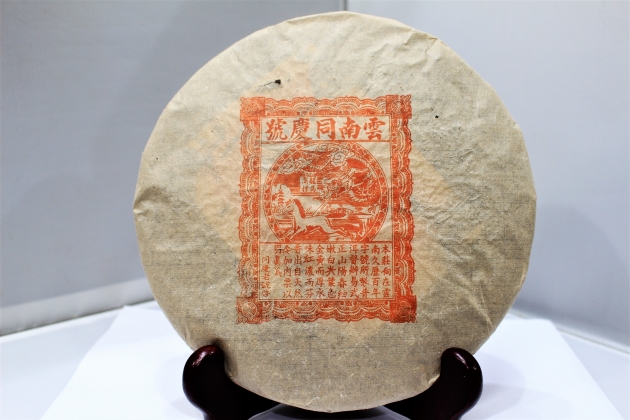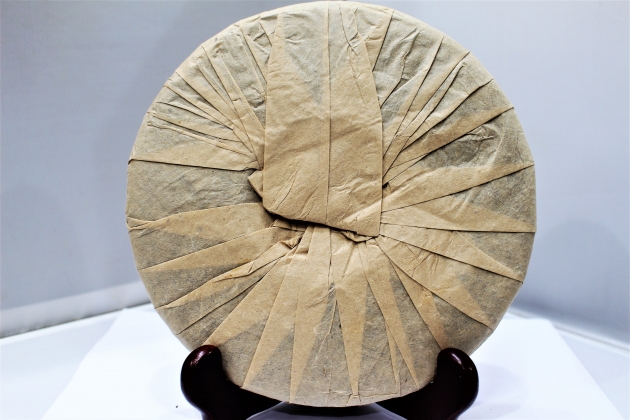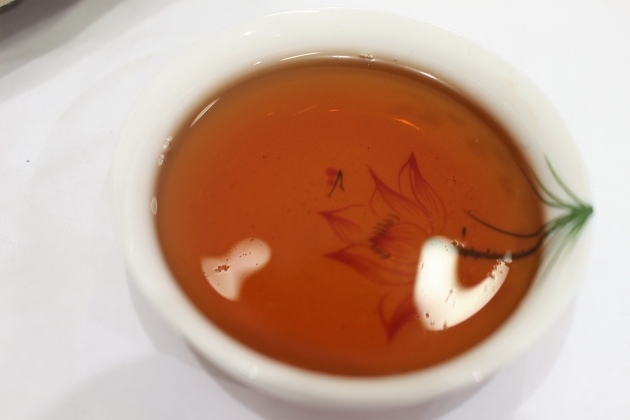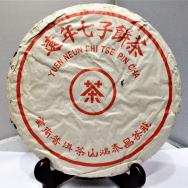1990s Tung Ching Hao- Yang Chun Dragon Horse Big NeiFei
產品說明
Info.
資料
資料
名稱:1990年代 【同慶號】陽春龍馬大內飛
工序:生茶
倉儲:傳統香港乾倉
重量:400克/餅,7餅/筒,84餅/箱
廠家:雲南同慶號茶莊
Name: 1990s Tung Ching Hao- Yang Chun Dragon Horse Big NeiFei
Process: Raw
Origin: Yi Wu, Yunnan Province
Storage: Natural Hong Kong Storage
Weight: 400g/cake,7 cakes/ton, 84 cakes/jian
Factory: Tung Ching Factory
A135
工序:生茶
倉儲:傳統香港乾倉
重量:400克/餅,7餅/筒,84餅/箱
廠家:雲南同慶號茶莊
Name: 1990s Tung Ching Hao- Yang Chun Dragon Horse Big NeiFei
Process: Raw
Origin: Yi Wu, Yunnan Province
Storage: Natural Hong Kong Storage
Weight: 400g/cake,7 cakes/ton, 84 cakes/jian
Factory: Tung Ching Factory
A135
History.
歷史
歷史
The first 5 infusions had a darker cup with cacao and fine wood tones, later infusions
were pleasant, mellow and light with (maybe original) flavour of the base material.
Interesting thing: even the tea seems matured and old, there were no flavours
of earth, very clean and tasty.
The "97’s TonChingHao" was the clear and very aromatic flavour of caco, spice and a bit coffee. Very delicious to drink. As some old cakes go for depth,
this one had more charming front-flavours
What do we know about Tung Ching Hao (Tong Qing Hao)?
The factory that has one of the longest history? The one sold at 200,000 rmb(appx. 30,000 USD)?
A Bing Wen Jia Bao gave British prime minister Gordon Brown as a precious gift?
Below is an article translated from Korean, wrote by Bak Yong Mo (famous Puerh book interpreter)
According to tea megazine, december's article wrote by Bak Yong Mo (famous interpreter of Chinese tea), one of the most famous 號級-Hao Ji Puerh Tong Qing Hao (同慶號) could be Shu Bing. Bak Yong Mo visited Zhang Shun Gao (張順高 : worked at Menghai Tea Leaf Research for 30 years and headed for the last 10 years, retired as a researcher at China Science Research Xishuang Banna tropical plant in 97) to hear opinions about making post-fermented tea by leaves grown in Korea and wrote down as followed.
Zhang Shun Gao showed him Tong Qing Hao Nei Piao Leaf is golden and thick, brewed color is red, strong flavor and great aroma. Nei Piao is inserted to distinguish from fake. Noticed by Tong Qing Chuan Hao Shu and explained "Color of leaf golden and taste of water 紅農-Hong Nong is no matter how to understand, doesn't fit the idea of Qing Bing and made leaf red, strong taste means tea after fermentation. To have red brewed color for Qing Bing requires at least 20 years, then it must hadn't made Nei Piap overseeing a change of few decades later. So this must mean fermented Shu.
Qing dynasty's Guangxi 21 year(1895), protocol with France "contructs commercial office in Yunnan Simao" and, 2 years later the same protocol was made with Britain. After researching and analyzed the facts during 1912 and 1923, exported Hong Cha via Simao was 白銀-Bao Yin 110,210 Liang(兩). Those teas were bought from Yiwu by Siping's sellers and exported. But in 1910, Yunnan didn't produce so-called Hong Cha yet, and produced few decades later. At this point, exported Hong Cha means fermented Puerh, Shu.
At that time, Tong Qing Hao when it is made, used Shu inside and Sheng outside actually to mix Sheng and Shu is easy but to mold by putting Mao Cha in a pocket so makes inside Shu/outside Sheng requires experienced skill. In 1930, Tong Shun Xiang's annual production was 500 Dan(1Dan is 75kg), Tong Chang was 400 Dan but Tong Qing Hao was 700 Dan so it was relatively big company."
Said by Zhang Shun Gao to insist that Tong Qing Hao was Shu.
If it is true, then it's a shocking news for tea enthusiasts because Qing Bing after 20 years. No after 30 years if it's perfectly Hong Kong or Taiwan traditional stored that coud be enjoyed without rejection. Then history of Puerh should be re-seen, and more ways of studies and analysis should be processed. But this is up to expert researchers', we consumers without asking Sheng or Shu, how old it is stored, how much it costs, Sheng is always good etc..should choose tea with no sanitizational problem and consider economic part that fits each one's taste.
“雲南同慶號”在清同治年間至清末為興盛時期,此期間,由劉順成和其子劉葵光經營茶莊,將毛茶工廠設在易武,
收集新鮮的大葉種普洱茶箐,聘請技藝精湛 的師傅做成質量精良的圓茶,
茶葉品質為思茅、普洱兩區之首,當時商家都稱同慶老號的茶為“易武正山陽春 茶”。
此茶暢銷海內外,尤被海外僑胞所讚賞。
"同慶",即普天同慶之意,同慶號成立伊始即設廠加工毛茶,
向易武各茶山的茶農採購最新鮮的大葉種茶,做成較好的毛茶。
同慶號在易武山也種植茶葉園,將精工製作好的茶葉銷售出去。
同慶號一向以信用可靠著名,凡是從同慶號出來的普洱茶都是品質上等的茶葉,
其普洱茶製造過程選料精當,加工技術頗為講究,經營以誠信為本。
圖上方寫“雲南同慶號”,中間為白馬、雲龍、寶塔圖案,
下方署:
“本莊向在雲南久歷百年字號
所制普洱督辦易武正山陽春細嫩的白尖葉
色金黃而厚水味紅濃而芬香出自天然
今加內票以明真偽同慶老字號啟”字樣。
該茶品湯色為深栗、但透澈,有蘭香,入口水路細柔滑順,由於其年代久遠,
餅沿已松動,剛上市時被一些人疑為邊境普洱,可一兩年後,人們識其本真,身價猛漲四、五倍。
與福元昌號的普洱茶那氣勢非凡的品質相比,同慶老號圓茶幽雅內斂,絕冠群倫,
是極柔和性的優美茶品,被視為國寶絕品,享有“普洱茶後”美譽。
were pleasant, mellow and light with (maybe original) flavour of the base material.
Interesting thing: even the tea seems matured and old, there were no flavours
of earth, very clean and tasty.
The "97’s TonChingHao" was the clear and very aromatic flavour of caco, spice and a bit coffee. Very delicious to drink. As some old cakes go for depth,
this one had more charming front-flavours
What do we know about Tung Ching Hao (Tong Qing Hao)?
The factory that has one of the longest history? The one sold at 200,000 rmb(appx. 30,000 USD)?
A Bing Wen Jia Bao gave British prime minister Gordon Brown as a precious gift?
Below is an article translated from Korean, wrote by Bak Yong Mo (famous Puerh book interpreter)
According to tea megazine, december's article wrote by Bak Yong Mo (famous interpreter of Chinese tea), one of the most famous 號級-Hao Ji Puerh Tong Qing Hao (同慶號) could be Shu Bing. Bak Yong Mo visited Zhang Shun Gao (張順高 : worked at Menghai Tea Leaf Research for 30 years and headed for the last 10 years, retired as a researcher at China Science Research Xishuang Banna tropical plant in 97) to hear opinions about making post-fermented tea by leaves grown in Korea and wrote down as followed.
Zhang Shun Gao showed him Tong Qing Hao Nei Piao
Qing dynasty's Guangxi 21 year(1895), protocol with France "contructs commercial office in Yunnan Simao" and, 2 years later the same protocol was made with Britain. After researching and analyzed the facts during 1912 and 1923, exported Hong Cha via Simao was 白銀-Bao Yin 110,210 Liang(兩). Those teas were bought from Yiwu by Siping's sellers and exported. But in 1910, Yunnan didn't produce so-called Hong Cha yet, and produced few decades later. At this point, exported Hong Cha means fermented Puerh, Shu.
At that time, Tong Qing Hao when it is made, used Shu inside and Sheng outside actually to mix Sheng and Shu is easy but to mold by putting Mao Cha in a pocket so makes inside Shu/outside Sheng requires experienced skill. In 1930, Tong Shun Xiang's annual production was 500 Dan(1Dan is 75kg), Tong Chang was 400 Dan but Tong Qing Hao was 700 Dan so it was relatively big company."
Said by Zhang Shun Gao to insist that Tong Qing Hao was Shu.
If it is true, then it's a shocking news for tea enthusiasts because Qing Bing after 20 years. No after 30 years if it's perfectly Hong Kong or Taiwan traditional stored that coud be enjoyed without rejection. Then history of Puerh should be re-seen, and more ways of studies and analysis should be processed. But this is up to expert researchers', we consumers without asking Sheng or Shu, how old it is stored, how much it costs, Sheng is always good etc..should choose tea with no sanitizational problem and consider economic part that fits each one's taste.
“雲南同慶號”在清同治年間至清末為興盛時期,此期間,由劉順成和其子劉葵光經營茶莊,將毛茶工廠設在易武,
收集新鮮的大葉種普洱茶箐,聘請技藝精湛 的師傅做成質量精良的圓茶,
茶葉品質為思茅、普洱兩區之首,當時商家都稱同慶老號的茶為“易武正山陽春 茶”。
此茶暢銷海內外,尤被海外僑胞所讚賞。
"同慶",即普天同慶之意,同慶號成立伊始即設廠加工毛茶,
向易武各茶山的茶農採購最新鮮的大葉種茶,做成較好的毛茶。
同慶號在易武山也種植茶葉園,將精工製作好的茶葉銷售出去。
同慶號一向以信用可靠著名,凡是從同慶號出來的普洱茶都是品質上等的茶葉,
其普洱茶製造過程選料精當,加工技術頗為講究,經營以誠信為本。
圖上方寫“雲南同慶號”,中間為白馬、雲龍、寶塔圖案,
下方署:
“本莊向在雲南久歷百年字號
所制普洱督辦易武正山陽春細嫩的白尖葉
色金黃而厚水味紅濃而芬香出自天然
今加內票以明真偽同慶老字號啟”字樣。
該茶品湯色為深栗、但透澈,有蘭香,入口水路細柔滑順,由於其年代久遠,
餅沿已松動,剛上市時被一些人疑為邊境普洱,可一兩年後,人們識其本真,身價猛漲四、五倍。
與福元昌號的普洱茶那氣勢非凡的品質相比,同慶老號圓茶幽雅內斂,絕冠群倫,
是極柔和性的優美茶品,被視為國寶絕品,享有“普洱茶後”美譽。
Taste.
品茶
品茶
陽春龍馬大內飛同慶號茶的條索細長而結實,經長期貯存,餅面呈深栗,帶有金黃色的芽尖,有細條茶梗,
果膠質濃厚,味甘黏杯,茶韻香甜,飽和順口,具多層次,具有同慶號原產地原生林的【橡樹味】。
苦、澀味道已經淡化,感覺入喉順口;陳化期足,水性厚, 茶質佳。
茶湯深栗色,但透澈,有一股幽雅蘭香,茶湯入口水路細柔滑順。
茶味淡淡,略帶甘蔗甜味。品嘗若同慶的滋味時,要擁有幾許若有若無的道家哲學意境。
茶湯經過口腔,不會留下苦味,也沒有澀感。然而,如古人所最為讚賞的'舌底鳴泉 " ,悠然而生。
依據一般品茗知識,能夠由舌根底下生津的,必須要有一定陳化年限的老茶。
以普洱茶品而 論,陳化在七入十年以上的好普洱茶,才會出現舌底鳴泉的 氣勢。
茶韻已很陳老,從茶湯中可以感覺到陳化時間的厚度,其生命力道極為微弱,但是卻非常的純正而深浚。
【湯色】茶湯深栗色、紅醇清澈。
【香氣】香氣高雅舒暢,具有同慶號原產地原生林的【橡樹味】。
【口感】入口水路細柔滑順。
果膠質濃厚,味甘黏杯,茶韻香甜,飽和順口,具多層次,具有同慶號原產地原生林的【橡樹味】。
苦、澀味道已經淡化,感覺入喉順口;陳化期足,水性厚, 茶質佳。
茶湯深栗色,但透澈,有一股幽雅蘭香,茶湯入口水路細柔滑順。
茶味淡淡,略帶甘蔗甜味。品嘗若同慶的滋味時,要擁有幾許若有若無的道家哲學意境。
茶湯經過口腔,不會留下苦味,也沒有澀感。然而,如古人所最為讚賞的'舌底鳴泉 " ,悠然而生。
依據一般品茗知識,能夠由舌根底下生津的,必須要有一定陳化年限的老茶。
以普洱茶品而 論,陳化在七入十年以上的好普洱茶,才會出現舌底鳴泉的 氣勢。
茶韻已很陳老,從茶湯中可以感覺到陳化時間的厚度,其生命力道極為微弱,但是卻非常的純正而深浚。
【湯色】茶湯深栗色、紅醇清澈。
【香氣】香氣高雅舒暢,具有同慶號原產地原生林的【橡樹味】。
【口感】入口水路細柔滑順。





















